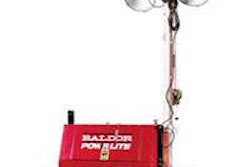 Legendary windmill tilter Don Quixote would surely be confused by Nevada DOT’s new innovation. It is a windmill, yes. But it looks nothing like a traditional windmill.
Legendary windmill tilter Don Quixote would surely be confused by Nevada DOT’s new innovation. It is a windmill, yes. But it looks nothing like a traditional windmill.
There are no propellers. It is a cylinder, and wind blows against the turbine’s vertical foils, causing them to spin. It costs about $6,000, roughly the same as three solar panels and it produces what those panels would produce. It is, of course, far safer for birds.
“Every penny we spend powering lights is not putting asphalt on the roads or buying fuel,” says NDOT Communications and Network Manager David Loar. “The less we spend on electrical power, the more we benefit and the better we can keep our highways maintained. The advantage with wind turbines is that they can run 24 hours a day. There is also a 20-year maintenance free warranty on the turbines while a solar panel’s useful lifespan is about 20 years.”
The vertical windmill is 20-feet high, supported by a 6-foot square concrete base. It generates a maximum of 1,200 watts of power. It has magnetic instead of traditional mechanical bearings which reduce friction, allowing the turbine to spin in very low winds.
The windmill, technically a “wind turbine,” sits on top of northwest Nevada’s nearly 9,000-foot Fox Mountain and provides back-up energy for a radio communications site. It is part of an ongoing NDOT program that investigates potential alternative energy sources that will both help the environment and save the department money.v
Join a National Study: ‘Chemical Treatments for Unpaved Roads’
Montana State University’s Western Transportation Institute (WTI) is conducting a survey as part of The National Scan of Best Practices for Chemical Treatments on Unpaved Roads and is seeking survey participants.
This survey takes about 20 minutes and is intended for practitioners, decision-makers and
researchers involved in unpaved road management. A diverse team of stakeholders under the sponsorship of Federal Highway Administration (FHWA) and the coordination of the WTI – developed the survey.
Participation in the anonymous survey will assist FHWA in identifying future research and documentation needs pertaining to effective and sustainable use of chemical treatments on unpaved roads.
To take the survey, go to www.roaddustinstitute.org. The survey link will remain active though Jan. 31.
For more information on the Western Transportation Institute at Montana State University, go to www.westerntransportationinstitute.org.
Could the bidding goalposts be moving?
Goal posts are a simple metaphor. When you are bidding for highway construction jobs, where they are is important. So is any possibility of their being moved.
Victor Mendez, Federal Highway Administration (FHWA) administrator, told a room crowded with representatives of companies that build concrete highways that he senses there may be some sort of goalpost creep when it comes to the future of highway construction job bids. Responding to questions at the annual meeting of the American Concrete Pavement Association in Orlando, Fla., Mendez said “there’s a lot of discussion about moving towards a performance management basis.”
There is talk, he said, although he did not identify who was talking or when, about “more of an outcome-based approach. I think we will go that way. I think we will be driven by outcome more than other factors” in the future, he said. “My sense is that is the direction we are moving in.”
This led to the mulling of the perennial question of whether there should be, or could be, national performance levels. Mendez, an old Arizona transportation hand, laid out briefly the basic arguments that are well known to the industry, acknowledging that Arizona and Florida and Oregon and Massachusetts are distinctly different in their needs and operations, and finished with: “Maybe.” v
Early Warming System
Solar power to prevent snow and ice on bridges
Perhaps you thought the idea is just to let the sun melt the snow and ice. But no.
The Missouri Department of Transportation (MoDOT) is about to become one of the first agencies in the nation to turn to solar energy in an effort to prevent the buildup of snow and ice on bridge decks.
MoDOT is installing a “solar warming system” on two bridges on either side of Excelsior Springs in Clay and Ray counties. Both are on Route 10, one to the east of Excelsior Springs over Route 69 and one to the west over the Fishing River. The two bridges are scheduled for deck replacements in 2010 as part of MoDOT’s “Safe & Sound Bridge Improvement Program” that is repairing or replacing 802 of the state’s worst bridges by the end of 2013. (See Better Roads’ “2009 Bridge Inventory” in the November 2009 print edition or go to www.betterroads.com for a full report on the nation’s best and worst bridges.)
The warming system, Pave Guard, operates much like radiant heating works in a home’s floor. Tubing is installed in the bridge deck, through which a heated solution is pumped to keep the deck from freezing. The energy to heat the solution is provided by solar panels mounted near the bridge site. Excess energy produced by the panels when the heating system is not in use can be sold back to local utilities.
“Water and the chemicals used to melt ice and snow are a bridge’s biggest enemies,” State Bridge Engineer Dennis Heckman says about the new solar heating system. “If we can find a cost effective way to keep a bridge clear without using chemicals we can extend its life.”
The bridge jobs will be put out for bids in February, with construction scheduled between April through August.
The Pave Guard systems are to be operable by November 2010. MoDOT will evaluate the performance of the systems before making a decision on whether to install more of them on other bridges.
* Audio and video soundbites from State Bridge Engineer Dennis Heckman can be found at www.modot.org/newsroom. More information on the solar technology can be found at www.paveguardtech.com/.











